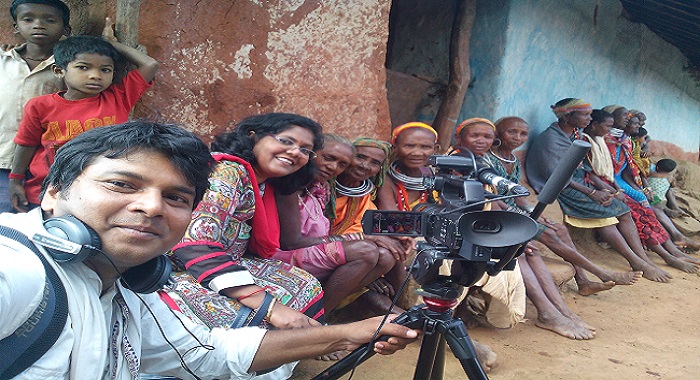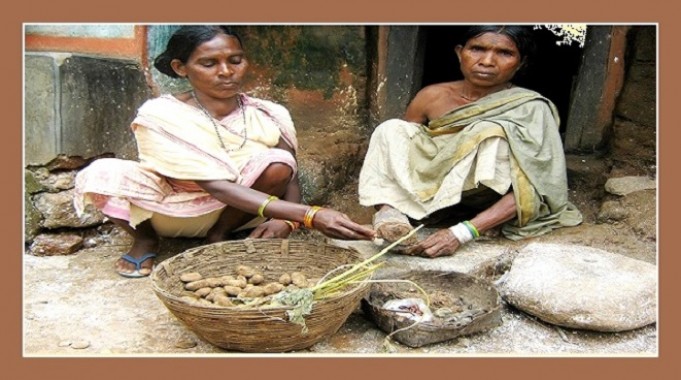Stories from the fastnesses of Odisha
Tribals preparing the mango kernel at Kashipur in Rayagada district
It was like a dream come true when I received a phone call telling me I had been selected for the Ramnath Goenka Award for Excellence in Journalism 2015 for Uncovering India Invisible. I have been chosen for my TV series titled Kete Katha Kete Byatha (Many Tales, Many Agony) which was shown on Kalinga TV.
This series was based on social and tribal issues. Having worked as a journalist for about two decades here in Odisha, I strongly feel that Odisha is still invisible in the mainstream media. The most marginalised people in the remote and inaccessible part of our state acquire space in newspapers and on TV channels when there is a starvation death, a child sale due to poverty, a malnutrition death or a big Maoist attack. Otherwise, hardly any media house bothers to bring their issues to the fore front.
Kalinga TV is a one-and-a- half year old Odia channel. I joined here as a Deputy Chief Editor after working for 16 years for ANI. When I decided to start this series, many questions were raised about TRPs. Our marketing people had doubts. They said that comedy shows, sensational news, and political news-based programmes were the ones that got the highest TRPs followed by revenue.
Logically they are correct. But I argued that, apart from the TRP and revenue, the media has some kind of social responsibility. Being a new channel, we had scope to experiment. I suggested that we become the first channel in Odisha to start a weekly half hour series dedicated to the social issues of concern to marginalised people.
My boss approved the idea. I started my shooting. I was aware of the challenges that I was going to face making these programmes. Identifying the issues is a challenge for any journalist but, thanks to my time at ANI, I had travelled across every corner of Odisha, covering stories from the most inaccessible areas about the most vulnerable sections of the society and so this task was not very difficult for me.
I started shooting from my home town, Bargarh, on farmer suicides. Twelve farmers had died in six months. There was hardly any news about this subject and if there was any, it was never more than a small item on the third or fourth page in a newspaper or a 40 second story towards the end of a TV news bulletin.

Sarada Lahangir and cameraman at Bonda Hill, Malkangiri district, where the primitive Bonda tribals live.
I had not seen any reporting on the ground. Many of my fellow journalists have an impression that farmer suicides are an issue only in Maharashtra.
Twelve farmers committing suicide in six months in a district is not a big story but for me it was significant because Bargarh district is not a barren wasteland but the rice bowl of Odisha. More than 70 percent of its cultivated land comes under the Hirakud command area which is a highly irrigated belt. If the farmers of this area are committing suicide, then there is something wrong.
I spoke to the families of the suicide victims, the farmers, local activists, government district officials, higher officials and ministers of agriculture and civil and food supplies. Then I made a half hour programme covering all aspects of the problem to understand why a farmer would end his life.
The episode was highly appreciated. The government machinery cranked into motion with the food and civil supplies department announcing it would open more Mandis (marketing outlets) for farmers to sell their produce easily at government rates rather than being forced into a distress sale of paddy.
The agriculture departments stepped in too, streamlining the crop insurance system, seed subsidies, farmers’ identity cards, etc. Many of the national dailies also started carrying the news of farmer suicides on their front page, followed by other TV channels reporting from the ground. Later, the Prime minister and then the Chief Minister visited Bargargh and spoke to the farmers’ families.
My second episode in the series was on the tribals of Kashipur, Rayagada district, about 570 kms from Bhubaneswar. Despite being rich in natural resources, Kashipur had made the headlines for starvation deaths in 2001 when 21 tribals died after consuming mango kernel gruel.
I had reported this incident extensively while working for ANI. I wanted to re- visit this place to try to find out if their lives had changed. I met a tribal couple, Neela and Pushe Majhi, who live in Panasguda hamlet. Their only daughter, Lachhi, died in 2001 at the age of 15 after eating mango kernel.
Given that 14 years had elapsed, I imagined the situation would be better. But when I and the camera crew entered their house, I found just half a kilo of rice in one of the earthen pots. In another pot was some Gurudi Sag (Gurudi leaves) that they had collected from the nearby forest and a potato dish. This was their food.
I learnt that the tribals who had received compensation for the 2001 deaths had exhausted it. After 69 years of independence, mango kernel gruel and tamarind seeds are their staple food during the rainy season when they don’t get any work.
Singhari Majhi, 72, of Bilamal village lost four members of her family in 2001 - her husband, two sons and daughter-in law. She recognised me. ‘Why have you come here? Nobody has died recently”.
When I pointed out that she had received compensation and was getting government rice at Rs 1 per kilo, Singhari replied: “If we have money we will get the PDS rice. But we have no money. Our land is taken away by the Utkal Alumina Company. Of course they have given some money as compensation but the land from where we get our food throughout the year was lost forever. Now the compensation money got exhausted. We are left with nothing. Tell me, how will we survive? I will also die without food like my family members.’
Then she took my hand, asked me to sit down and spoke: ‘Everybody forgot us, including you. Of course, you are the only person who has re-visited us after 14 years. Look at us, at how distressed we are even today. Have you brought anything for us?”
Somewhere, we journalists are failing because once we have covered a story, we hardly ever do any follow up. If we did, the authorities would be forced to take action. But unfortunately it does not happen.
Another episode was on women in conflict zones. For 20 years, Odisha has been facing a Maoist insurgency in about 23 districts out of 30. The lives of the common people are affected by the Maoist menace but most of all it is the women and children who struggle the most under the cloud of the terror.
I met some of the women Maoists and tried to find out under what circumstances they have joined the movement. I learnt that most of them have joined either by force or by lure. But the root cause was essentially deep-rooted poverty, deprivation, and the lack of basic health and education.
Some female Maoists who had surrendered complained of sexual exploitation when they were in the camp and also of exclusion once they had surrendered because their family and society refused to accept them. Another group of women lived in the Red Zone and their relatives are Maoists; these women are harassed by the security forces.
Last but not least I met women who have nothing to do with the Maoists but, since they live in Maoist areas, no government scheme reaches them and they live without basic facilities.
In this way, I have done 37 episodes so far to highlight what is wrong with the lives of the poorest in Odisha. The biggest challenge with these stories was simply reaching the affected people or the victims because their homes, surrounded by hills and difficult terrain and sometimes by the Maoists, are very difficult to access. Sometimes we walked 10 kms to reach the people we wanted to meet.
Today, I am happy to get this award but I would be happier if I, as a journalist, could really bring some change to the lives of people like Singhari and Pushe.







